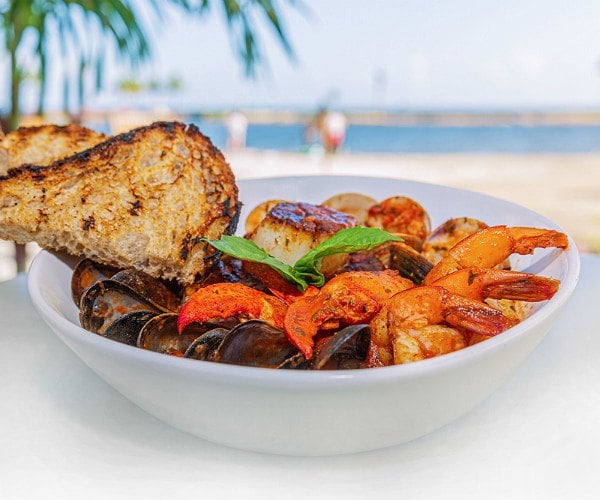A Guide to Cioppino: A Classic Italian Seafood Dish

# A Comprehensive Guide to Cioppino: An Authentic Italian Seafood Stew
Cioppino is a cherished seafood stew that originates from the Italian-American culinary heritage, particularly linked to the seaside city of San Francisco. This robust dish showcases the ocean’s offerings, blending an assortment of fresh seafood in a savory, rich broth. In this guide, we will delve into the history of cioppino, its essential components, cooking techniques, and suggestions for serving this scrumptious stew.
## The History of Cioppino
The origins of cioppino can be traced back to the late 1800s, when Italian fishermen settled in San Francisco. It is thought that the dish draws inspiration from traditional Italian fish stews, such as “cacciucco” from Tuscany. Fishermen often crafted this stew using the fresh catch of the day, incorporating whatever seafood was on hand, alongside tomatoes, garlic, and wine. The term “cioppino” is believed to stem from the Italian word “cioppare,” which means “to chop,” reflecting the method of ingredient preparation.
## Essential Ingredients
Though cioppino recipes can differ significantly, the following components are typically found in this savory stew:
1. **Seafood**: The spotlight of cioppino is certainly the seafood. Popular selections include:
– Dungeness crab
– Clams
– Mussels
– Shrimp
– Scallops
– Fish (like cod, halibut, or snapper)
2. **Broth**: The stew’s foundation is usually made from tomatoes, either fresh or canned, combined with seafood stock or broth. Some variations also include white or red wine for an extra layer of flavor.
3. **Aromatics**: Key flavor elements include garlic, onions, and occasionally shallots. Fresh herbs such as parsley and basil are often used as garnishes.
4. **Spices**: Red pepper flakes can provide a hint of heat, while bay leaves and black pepper enrich the overall flavor profile.
5. **Accompaniments**: Cioppino is frequently served with crusty bread or garlic bread, ideal for soaking up the delicious broth.
## Preparation Steps
Creating cioppino is a simple process that allows the fresh seafood to take center stage. Here’s a basic outline for preparing this delightful stew:
### Ingredients:
– 1/4 cup olive oil
– 1 onion, chopped
– 4 cloves garlic, minced
– 1 can (28 oz) crushed tomatoes
– 1 cup seafood stock
– 1 cup dry white wine
– 1 teaspoon red pepper flakes (if desired)
– 1 bay leaf
– Salt and black pepper to taste
– 1 lb Dungeness crab, cleaned and cut into pieces
– 1 lb shrimp, peeled and deveined
– 1 lb mussels, cleaned
– 1 lb clams, cleaned
– Fresh parsley, chopped (for garnish)
– Crusty bread (for serving)
### Instructions:
1. **Sauté Aromatics**: In a large pot or Dutch oven, warm the olive oil over medium heat. Add the chopped onion and sauté until translucent, about 5 minutes. Incorporate the minced garlic and cook for another minute until fragrant.
2. **Combine Liquids**: Add the crushed tomatoes, seafood stock, and white wine. Stir to blend and bring the mixture to a simmer.
3. **Season the Broth**: Introduce the red pepper flakes, bay leaf, salt, and black pepper. Allow the broth to simmer for approximately 15 minutes to let the flavors meld together.
4. **Incorporate Seafood**: Carefully add the crab, shrimp, mussels, and clams to the pot. Cover and cook for an additional 5-10 minutes, or until the mussels and clams have opened and the shrimp are thoroughly cooked.
5. **Serve**: Remove the bay leaf, taste, and adjust the seasoning if needed. Spoon the cioppino into bowls, garnish with fresh parsley, and serve hot with crusty bread on the side.
## Tips for Making the Perfect Cioppino
– **Freshness Matters**: The quality of the seafood is essential for a delectable cioppino. Use fresh, sustainably sourced seafood whenever possible.
– **Customize Ingredients**: Feel free to adjust the types of seafood based on your preferences or what’s available. The versatility of cioppino is one of its highlights.
– **Prepare in Advance**: Cioppino can be prepared a few hours ahead and reheated before serving, allowing the flavors to deepen.
– **Wine Pairings**: A crisp white wine, such as Sauvignon Blanc or Pinot Grigio, complements cioppino beautifully, enhancing the seafood flavors.
## Conclusion
Cioppino is more than merely a seafood stew; it’s